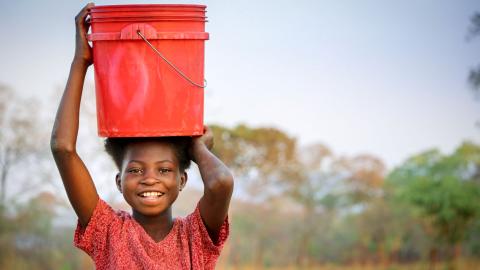
Water, Sanitation and Hygiene
What we want to do:
We want to see all children enjoy access to clean water and improved sanitation facilities close to their homes so that they can stay well. We are working towards this by:
- Ensuring safe and equitable access to clean water for all
- Increasing the number of households with access to improved sanitation facilities
- Ensuring all families know the importance of and use proper hygiene practices
What is the problem?
Access to clean water is unequal. In Zambia, 90 percent of households in urban areas have access to safe water compared to only 53 percent of households in rural areas.
Urban areas also have higher access to sanitation at 70 percent, compared to rural populations, whose access is only at 25 percent. Limited access to water, sanitation, and hygiene (WASH) are the main causes of infections, such as diarrhoea, in the country. Inadequate WASH facilities and practices continue to be the leading cause of death of children under the age of 5 in Zambia (ZDHS, 2014).
Our Water, Sanitation, and Hygiene (WASH) work is the foundation for all other Zambia intervention areas. Without adequate water and sanitation, children cannot attend school, their health is compromised, their livelihoods are threatened, and children are often vulnerable to external threats while collecting water.
How is World Vision addressing the issues?
For the past 30 years, World Vision Zambia has been providing access to clean and safe water across the country. Over the years, we have sunk boreholes in 28 districts where we are currently implementing activities. This is in response to the current lack of clean and safe water in the country. Thirty-two percent of people lack access to improved water supply, with rural areas heavily affected. Forty-nine percent of the rural population relies on unsafe sources compared to just ten percent of the urban population. National access to proper sanitation is low at forty percent. In rural areas, access to improved sanitation is even lower at fifteen percent compared to seventy-thee percent for the urban population. The poor water supply and sanitation services, especially in rural areas, contribute to a high burden of water-borne diseases such as diarrhoea and cholera in Zambia. Diarrheal diseases are responsible for nine percent of under-5 mortalities in Zambia.
Our projects implemented include the drilling and rehabilitating of boreholes and, more recently, mechanization. This system connects one borehole to strategic points such as health facilities, schools, and several clustered households with piped water using a solar system. Since 2008, we have drilled 4,403 boreholes, benefiting 1.1 billion people. Under the hygiene and sanitation sector, we are working with schools and households in behavioural change messages and in addition, the construction and upgrading of latrines. Over the next three years, we have committed to providing clean water to 1.2 million people across Zambia.
For the past 30 years, World Vision Zambia has provided access to clean and safe water across the country. Over the years, we have sunk boreholes in 28 districts where we are currently implementing activities. This is in response to the current lack of clean and safe water in the country. Thirty-two percent lack access to improved water supply, with rural areas heavily affected. Forty-nine percent of the rural population relies on unsafe sources compared to just ten percent of the urban population. National access to proper sanitation is low at forty percent. In rural areas, access to improved sanitation is even lower at fifteen percent compared to seventy-thee percent for the urban population. The poor water supply and sanitation services, especially in rural areas, contribute to a high burden of water-borne diseases such as diarrhoea and cholera in Zambia. Diarrheal diseases are responsible for nine percent of under-5 mortalities in Zambia.
Our projects include drilling and rehabilitating boreholes and, more recently, mechanization. Using a solar system, this system connects one borehole to strategic points such as health facilities, schools, and several clustered households with piped water. Since 2008, we have drilled 4,403 boreholes, benefiting 1.1 million people. Under the hygiene and sanitation sector, we are working with schools and households in behavioural change messages and constructing and upgrading latrines. Over the next three years, we have committed to providing clean water to 1.2 million people across Zambia.
Is what World Vision doing working?
Yes! World Vision International is reaching one new person with clean water every I0 seconds and three more schools daily with clean water. In the Fiscal year of 2021, we increased access to clean and safe water for 213,274 people in our operational areas. In addition, 307,635 people had access to improved sanitation facilities at the household level, recording an increase of 28% from the previous year.
What’s the impact?*
- From 2010 to 2020, we built or rehabilitated nearly 8,500 water points, including wells with hand pumps and taps from more than 200 piped-water systems, serving more than 1.5 million people.
- we reached 1.7 million people with improved sanitation facilities and educated 1.4 million people in healthy hygiene practices, resulting in 3,335 communities being certified Open Defecation Free.
- In 2021, we increased access to clean and safe water for213,274 people in our operational areas. In addition, 307,635 people had access to improved sanitation facilities at the household level, recording an increase of 28% from the previous year.
To learn more, download the Water Sanitation and Hygiene Capacity Statement.